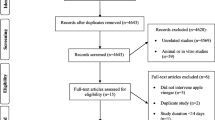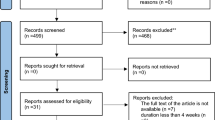Abstract
Purpose
Diets rich in plant-derived polyphenols such as olive oil (OO) and/or catechins such as epigallocatechin 3-gallate (EGCG) have been shown to reduce the incidence of cardiovascular diseases, potentially by improving endothelial function, an important surrogate for atherosclerosis. The possible augmentation of endothelial function with the combined efforts of OO and EGCG is intriguing, yet unknown.
Methods
Eighty-two patients with early atherosclerosis (presence of endothelial dysfunction) were enrolled in this double-blind, randomized trial with 52 completing the study. The aim of the study was to compare the effect of a daily intake of 30 ml simple OO, with 30 ml of EGCG-supplemented OO, on endothelial function as well as on inflammation and oxidative stress after a period of 4 months. Endothelial function was assessed noninvasively via peripheral arterial tonometry (Endo-PAT®).
Results
After 4 months, when OO and EGCG-supplemented OO groups were combined, OO significantly improved endothelial function (RHI, 1.59 ± 0.25–1.75 ± 0.45; p < 0.05). However, there were no significant differences in results between the two olive oil groups. Interestingly, with OO supplementation there was a significant reduction in inflammatory parameters: sICAM (196 to 183 ng/mL, p = < 0.001); white blood cells (WBCs) (6.0 × 109/L–5.8 × 109/L, p < 0.05); monocytes (0.48 × 109/L to 0.44 × 109/L, p = 0.05); lymphocytes (1.85 × 109/L to 1.6 × 109/L, p = 0.01); and platelets (242–229 × 109/L, p = 0.047).
Conclusions
Improvement in endothelial dysfunction in patients with early atherosclerosis in association with significant reduction in leukocytes may suggest an important role of early cellular inflammatory mediators on endothelial function. The current study supports one potential mechanism for the role of olive oil, independent of EGCG, modestly supplemented to a healthy cardiovascular diet.



Similar content being viewed by others
References
Basu A, Sanchez K, Leyva MJ, Wu M, Betts NM, Aston CE, Lyons TJ (2010) Green tea supplementation affects body weight, lipids, and lipid peroxidation in obese subjects with metabolic syndrome. J Am Coll Nutr 29:31–40
Bazzano L, He J, Ogden LG, Loria CM, Vupputuri S, Myers L, Whelton PK (2002) Fruit and vegetable intake and risk of cardiovascular disease in US adults: the first National Health and Nutrition Examination Survey Epidemiologic Follow-up Study. Am J Clin Nutr 76:93–99
Bonetti P, Holmes DR Jr, Lerman A, Barsness GW (2003) Enhanced external counterpulsation for ischemic heart disease: what’s behind the curtain? J Am Coll Cardiol 41:1918–1925
Bonetti P, Pumper GM, Higano ST, Holmes DR Jr, Kuvin JT, Lerman A (2004) Noninvasive identification of patients with early coronary atherosclerosis by assessment of digital reactive hyperemia. J Am Coll Cardiol 44:2137–2141
Brown A, Lane J, Coverly J, Stocks J, Jackson S, Stephen A, Bluck L, Coward A, Hendrickx H (2009) Effects of dietary supplementation with the green tea polyphenol epigallocatechin-3-gallate on insulin resistance and associated metabolic risk factors: randomized controlled trial. Br J Nutr 101:886–894
Covas M, Nyyssönen K, Poulsen HE, Kaikkonen J, Zunft HJ, Kiesewetter H, Gaddi A, de la Torre R, Mursu J, Bäumler H, Nascetti S, Salonen JT, Fitó M, Virtanen J, Marrugat J, EUROLIVE Study Group (2006) The effect of polyphenols in olive oil on heart disease risk factors: a randomized trial. Ann Intern Med 145:333–341
Dohadwala M, Holbrook M, Hamburg NM, Shenouda SM, Chung WB, Titas M, Kluge MA, Wang N, Palmisano J, Milbury PE, Blumberg JB, Vita JA (2011) Effects of cranberry juice consumption on vascular function in patients with coronary artery disease. Am J Clin Nutr 93:934–940
Elkind M, Sciacca RR, Boden-Albala B, Tondella ML, Feikin DR, Fields BS, Sacco RL, Di Tullio MR, Homma S (2005) Leukocyte count is associated with reduced endothelial reactivity. Atherosclerosis 181:329–338
Flammer A, Martin EA, Gössl M, Widmer RJ, Lennon RJ, Sexton JA, Loeffler D, Khosla S, Lerman LO, Lerman A (2012) Polyphenol-rich cranberry juice has a neutral effect on endothelial function but decreases the fraction of osteocalcin-expressing endothelial progenitor cells. Eur J Nutr [Epub ahead of print]. PMID 22382203
Ford M, McConnell JP, Lavi S, Rihal CS, Prasad A, Sandhu GS, Hartman SJ, Lerman LO, Lerman A (2009) Coronary artery endothelial dysfunction is positively correlated with low density lipoprotein and inversely correlated with high density lipoprotein subclass particles measured by nuclear magnetic resonance spectroscopy. Atherosclerosis 207:111–115
Fung T, Rexrode KM, Mantzoros CS, Manson JE, Willett WC, Hu FB (2009) Mediterranean diet and incidence of and mortality from coronary heart disease and stroke in women. Circulation 119:1093–1100
Goor D, Sheffy J, Schnall RP, Arditti A, Caspi A, Bragdon EE, Sheps DS (2004) Peripheral arterial tonometry: a diagnostic method for detection of myocardial ischemia induced during mental stress tests: a pilot study. Clin Cardiol 27:137–141
Higashi Y, Sasaki S, Nakagawa K, Kimura M, Noma K, Hara K, Jitsuiki D, Goto C, Oshima T, Chayama K, Yoshizumi M (2006) Tetrahydrobiopterin improves aging-related impairment of endothelium-dependent vasodilation through increase in nitric oxide production. Atherosclerosis 186:390–395
Hu F, Willett WC (2002) Optimal diets for prevention of coronary heart disease. JAMA 288:2569–2578
Jiménez-Morales A, Ruano J, Delgado-Lista J, Fernandez JM, Camargo A, López-Segura F, Villarraso JC, Fuentes-Jiménez F, López-Miranda J, Pérez-Jiménez F (2011) NOS3 Glu298Asp polymorphism interacts with virgin olive oil phenols to determine the postprandial endothelial function in patients with the metabolic syndrome. J Clin Endocrinol Metab 96:1694–1702
Lavi S, Prasad A, Yang EH, Mathew V, Simari RD, Rihal CS, Lerman LO, Lerman A (2007) Smoking is associated with epicardial coronary endothelial dysfunction and elevated white blood cell count in patients with chest pain and early coronary artery disease. Circulation 115:2621–2627
Lavie P, Shlitner A, Sheffy J, Schnall RP (2000) Peripheral arterial tonometry: a novel and sensitive non-invasive monitor of brief arousals during sleep. Isr Med Assoc J 2:246–247
Lerman A, Zeiher AM (2005) Endothelial function: cardiac events. Circulation 111:363–368
Lorenz M, Wessler S, Follmann E, Michaelis W, Düsterhöft T, Baumann G, Stangl K, Stangl V (2004) A constituent of green tea, epigallocatechin-3-gallate, activates endothelial nitric oxide synthase by a phosphatidylinositol-3-OH-kinase-, cAMP-dependent protein kinase-, and Akt-dependent pathway and leads to endothelial-dependent vasorelaxation. J Biol Chem 279:6190–6195
Perez-Jimenez F et al (2005) International conference on the healthy effect of virgin olive oil. Eur J Clin Invest 35:421–424
Prentice R, Szatrowski TP, Fujikura T, Kato H, Mason M, Hamilton HH (1982) Leukocyte counts and coronary heart disease in a Japanese cohort. Am J Epidemiol 116:496–509
Ridker P, Hennekens CH, Roitman-Johnson B, Stampfer MJ, Allen J (1998) Plasma concentration of soluble intercellular adhesion molecule 1 and risks of future myocardial infarction in apparently healthy men. Lancet 35:88–92
Romani A, Pinelli P, Mulinacci N, Galardi C, Vincieri FF, Liberatore L, Cichelli A (2001) HPLC and HRGC analyses of polyphenols and secoiridoids in olive oil. Chromatographia 53:279–284
Ruano J, Lopez-Miranda J, Fuentes F, Moreno JA, Bellido C, Perez-Martinez P, Lozano A, Gómez P, Jiménez Y, Pérez Jiménez F (2005) Phenolic content of virgin olive oil improves ischemic reactive hyperemia in hypercholesterolemic patients. J Am Coll Cardiol 46:1864–1868
Schmidt K, Werner ER, Mayer B, Wachter H, Kukovetz WR (1992) Tetrahydrobiopterin-dependent formation of endothelium-derived relaxing factor (nitric oxide) in aortic endothelial cells. Biochem J 281:297–300
Schmitt C, Dirsch VM (2009) Modulation of endothelial nitric oxide by plant-derived products. Nitric Oxide 21:77–91
Selamet-Tierney E, Newburger JW, Gauvreau K, Geva J, Coogan E, Colan SD, Ferranti SD (2009) Endothelial pulse amplitude testing: feasibility and reproducibility in adolescents. J Pediatr 154:901–905
Siqueira J, Smiley D, Newton C, Le NA, Gosmanov AR, Spiegelman R, Peng L, Osteen SJ, Jones DP, Quyyumi AA, Ziegler TR, Umpierrez GE (2011) Substitution of standard soybean oil with olive oil-based lipid emulsion in parenteral nutrition: comparison of vascular, metabolic, and inflammatory effects. J Clin Endocrinol Metab 96:3207–3216
Stocker R (1999) Dietary and pharmacological antioxidants in atherosclerosis. Curr Opin Lipidol 10:589–597
Sweetnam P, Thomas HF, Yarnell JW, Baker IA, Elwood PC (1997) Total and differential leukocyte counts as predictors of ischemic heart disease: the caerphilly and speedwell studies. Am J Epidemiol 145:416–421
Tousoulis D, Papageorgiou N, Antoniades C, Giolis A, Bouras G, Gounari P, Stefanadi E, Miliou A, Psaltopoulou T, Stefanadis C (2010) Acute effects of different types of oil consumption on endothelial function, oxidative stress status and vascular inflammation in healthy volunteers. Br J Nutr 103:43–49
Versari D, Daghini E, Rodriguez-Porcel M, Sattler K, Galili O, Pilarczyk K, Napoli C, Lerman LO, Lerman A (2006) Chronic antioxidant supplementation impairs coronary endothelial function and myocardial perfusion in normal pigs. Hypertension 47:475–481
Visioli F, Caruso D, Grande S, Bosisio R, Villa M, Galli G, Sirtori C, Galli C (2005) Virgin Olive Oil Study (VOLOS): vasoprotective potential of extra virgin olive oil in mildly dyslipidemic patients. Eur J Nutr 44:121–127
Walker AE, Seibert SM, Donato AJ, Pierce GL, Seals DR (2010) Vascular endothelial function is related to white blood cell count and myeloperoxidase among healthy middle-aged and older adults. Hypertension 55:363–369
Wheeler J, Mussolino ME, Gillum RF, Danesh J (2004) Associations between differential leucocyte count and incident coronary heart disease: 1764 incident cases from seven prospective studies of 30 374 individuals. Eur Heart J 25:1287–1292
Widlansky M, Hamburg NM, Anter E, Holbrook M, Kahn DF, Elliott JG, Keaney JF, Vita JA (2007) Acute EGCG supplementation reverses endothelial dysfunction in patients with coronary artery disease. J Am Coll Nutr 26:95–102
Woodman R, Watts GF, Puddey IB, Burke V, Mori TA, Hodgson JM, Beilin LJ (2002) Leukocyte count and vascular function in Type 2 diabetic subjects with treated hypertension. Atherosclerosis 163:175–181
Yokozawa T, Nakagawa T, Kitani K (2002) Antioxidative activity of green tea polyphenol in cholesterol-fed rats. J Agric Food Chem 50:3549–3552
Acknowledgments
This study was partly supported by Olivi Agri Team Srl, Grosetto, Italy, and the University of Florence. However, the study was investigator initiated and investigator driven. The clinical trial was conducted using Olive Oil and EGCG from Olivi Agri Company. This work was also partly supported by NIH grant #HL085307. AJF received a scholarship from the Walter and Gertrud Siegenthaler Foundation, Zurich, and is supported by a “Nachwuchsförderungskredit” of the young academics Support Committee of the University of Zurich, Switzerland, and the Swiss National Science Foundation (PASMP3_132551).
Conflict of interest
The authors report no actual or potential conflict of interest in connection with this study.
Author information
Authors and Affiliations
Corresponding author
Additional information
R. J. Widmer and M. A. Freund contributed equally.
Rights and permissions
About this article
Cite this article
Widmer, R.J., Freund, M.A., Flammer, A.J. et al. Beneficial effects of polyphenol-rich olive oil in patients with early atherosclerosis. Eur J Nutr 52, 1223–1231 (2013). https://doi.org/10.1007/s00394-012-0433-2
Received:
Accepted:
Published:
Issue Date:
DOI: https://doi.org/10.1007/s00394-012-0433-2




